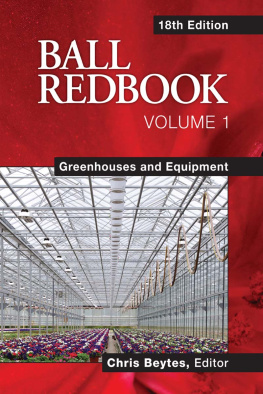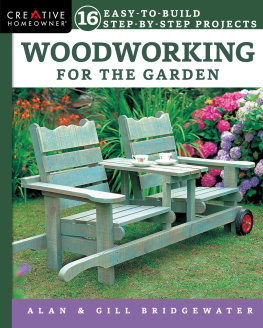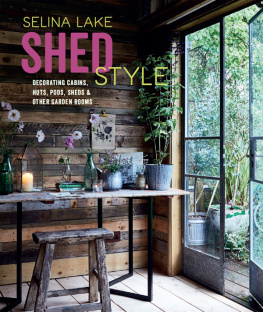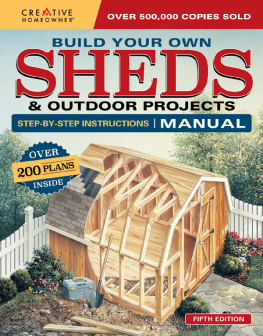GREENHOUSES &
GARDEN SHEDS
Inspiration, Information & Step-by-Step Projects
PAT PRICEwith
NORA RICHTER GREER
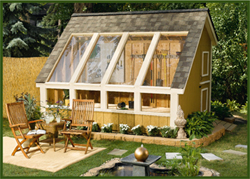


Copyright 2009
Creative Publishing international, Inc.
400 First Avenue North, Suite 300
Minneapolis, Minnesota 55401
1-800-328-0590
www.creativepub.com
All rights reserved
Printed in Singapore
10 9 8 7 6 5 4 3 2 1
Digital edition: 978-1-61673-919-5
Hardcover edition: 978-1-61673-919-5
Library of Congress
Cataloging-in-Publication Data
Price, Pat.
Greenhouses & garden sheds : inspiration, information & step-by-step projects / Pat Price; with Nora Richter Greer.
p. cm.
Summary: Provides step-by-step photos and instructions for a variety of building projects involving and relating to greenhouses and potting sheds--Provided by publisher.
Includes index.
ISBN-13: 978-1-58923-437-6 (soft cover)
ISBN-10: 1-58923-437-5 (soft cover)
1. Greenhouses--Design and construction.
2. Potting sheds--Design and construction.
I. Greer, Nora Richter. II. Title. III. Title:
Greenhouses and garden sheds.
SB416.P75 2008
690.8924--dc22
2008034555
President/CEO: Ken Fund
VP for Sales & Marketing: Kevin Hamric
Home Improvement Group
Publisher: Bryan Trandem
Managing Editor: Tracy Stanley
Senior Editor: Mark Johanson
Editor: Jennifer Gehlhar
Creative Director: Michele Lanci-Altomare
Senior Design Managers: Jon Simpson, Brad Springer
Design Managers: James Kegley
Lead Photographer: Steve Galvin
Photo Coordinator: Joanne Wawra
Shop Manager: Bryan McLain
Shop Assistant: Cesar Fernandez Rodriguez
Production Managers: Linda Halls, Laura Hokkanen
Page Layout Artists: Tiffany Laschinger/ Jessica Hannon
Illustrations: Robert Leanna II
Photographer: Andrea Rugg
Shop Help: Charlie Boldt, Scott Boyd, Dave Hartley
Copy Editor: Ami Johnson
Technical Editor: Karen Ruth
Photo Research: Betsy Gammons
Contents
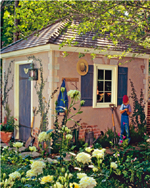
Chapter One
Greenhouses
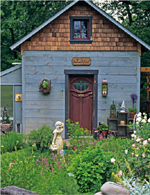
Chapter Two
Garden Sheds

Chapter Three
Greenhouse & Garden Shed Projects
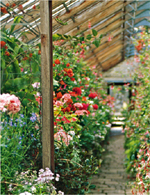
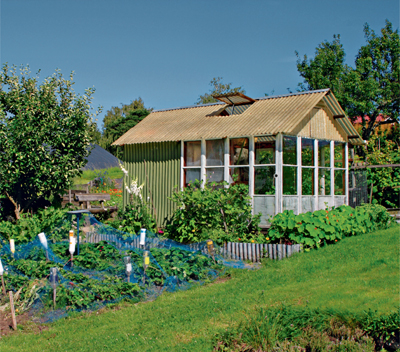
Introduction
GARDENERS ARE PASSIONATE. WE REJOICE when seedlings push their green tips through the soil. We revel in the scent of jasmine on a summer evening. We are persistent in our struggle with garden pests and the weather, carefully picking aphids from tomatoes and protecting lettuce plants from frost. We water, we fertilize, we coax, we coddle. And as flakes of snow descend on our barren backyards, many of us yearn for the opportunity to garden year-round in a greenhouse.
What avid gardener hasnt dreamed of bending the rules of nature just a bit, starting spring a little earlier, extending summer into October, or creating a tropical paradise in the coldest of locales? What could be more satisfying than thumbing your nose at the wind and rain from the warm embrace of a greenhouse?
Gardening structures have fallen in and out of fashion since the days when they were essentially dung-filled pits covered with mica. Today they are widely available in a variety of styles and sizes to match just about any budget. New materials and methods have reduced the costs of constructing, heating, and maintaining greenhouses, and kits are making them ever easier to build. But a wealth of choices leads to a host of questions: What style should I choose? What design is best suited to my property? How big should it be? Do I need a greenhouse, or will a garden shed do?
In the following chapters, youll learn how to decide what type of structure is right for your needs, where and how to build it, what materials to use, and how to maintain it. You will see clear step-by-step photos of several structures as theyre built, along with complete instructions for many easy-to-make accessories. Best of all, youll find inspiration on pages packed with photos, designs, and ideas to ignite your imagination.
GREENHOUSES IN HISTORY
Gardening under glass is not a new concept. As far back as the first century A.D., the Romans, whose achievements included aqueducts, straight roads, and toilets with running water, were experimenting with growing vegetables and fruit in speculariarudimentary greenhouses clad in thin sheets of mica. But the popularity of these structures declined along with the Roman Empire, and greenhouses didnt reappear until much later, with the northern European countries first attempts at indoor gardening.
Italy and France developed the first protected gardens in the 1600s (although the French were reportedly forcing flowers in glass structures as early as 1385), and the Dutch and the British soon followed suit. By the 17th century, explorers were bringing home hundreds of exotic plant species, including citrus trees, and the British were eager to grow them. They invented the orangery, an unheated structure with a solid roof and glass walls that was designed to protect precious orange and lemon trees from frost in the winter and served as a social gathering place in the summer, when the trees were moved out into the garden.
Britains first conservatories were also built at this time, largely for the benefit of scientists, whose main interest was in growing plants for medicinal and research purposes. In the mid-1800s, the aristocracy began to build huge glass-and-wrought-iron structures, such as the Palm House at the Royal Botanic Gardens at Kew and the Great Conservatory at Chatsworth. Soon every wealthy landowner had to have a conservatory, not just to house exotic palm trees and plants but to entertain guests and provide secluded meeting places for lovers. After the tax on glass was abolished in 1845 and the fantastic Crystal Palace was built for the Great Exhibition in 1851, greenhouses and conservatories became all the rage in Britain.
Their popularity waned, however, during World War I. As gardeners went off to battle and heating costs became prohibitive, conservatories fell victim to rust and neglect. Even the conservatory at Chatsworth succumbed; too expensive to maintain, it was demolished in 1920. But times change, and technological advances and new architectural designs have made modern greenhouses desirable, practical, and affordable, even for budget-conscious gardeners.


